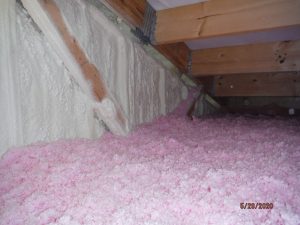Blown-In Fiberglass Attic Insulation
In Climate Zones 3 and higher blown-in fiberglass attic insulation is extremely popular due to lower investment cost and high performance.
Looking for a best solution for your barndominium or post frame attic? It is inevitable an insulation contractor will warn you away from blown-in fiberglass due to a dated study proving fiberglass insulation loses up to half its R-value due to internal convection. It is important to understand this study’s results.
Titled Thermal Performance of Fiberglass and Cellulose Attic Insulations, this paper describes research done by Kenneth E. Wilkes and Phillip W Childs at Oak Ridge National Laboratory 30 years ago.
Wilkes and Childs set up an attic test module simulating temperature differences across an insulated attic floor. Basically they put a whole roof and attic assembly into big chamber and measured R-values of three insulation types:
- Loose-fill fiberglass
- Fiberglass batts
- Loose-fill cellulose
They kept temperature below the ceiling drywall at 70° F and varied the exterior temperature from 45° F down to -18° F. Here’s what they found:
- Fiberglass batts and loose-fill cellulose performed as expected at a whole range of temperature differences.
- Loose-fill fiberglass showed a significant reduction in R-value as the attic got colder and the temperature difference got larger.
 Loose-fill fiberglass lost 35% to 50% of its resistance to heat flow at temperature differences of 70° F to 76° F. This loss of R-value started at a temperature difference of about 32° F. With temperature below ceiling drywall held at 70° F, R-value started dropping when attic temperature was reduced to 38° F and had lost 35-50% when attic temperature got to 0° F and below.
Loose-fill fiberglass lost 35% to 50% of its resistance to heat flow at temperature differences of 70° F to 76° F. This loss of R-value started at a temperature difference of about 32° F. With temperature below ceiling drywall held at 70° F, R-value started dropping when attic temperature was reduced to 38° F and had lost 35-50% when attic temperature got to 0° F and below.
In looking at this data, researchers saw a pattern leading them to suspect convection within insulation as the culprit. They did some calculations and further experimentation and concluded this was indeed what was occurring. Further experimentation they did was to put a covering layer over the loose-fill fiberglass top. They tried both a polyethylene film and fiberglass blanket combination and (2) R-19 fiberglass batts. Both eliminated convection and reduction in R-value.
If our story ended here, the lesson learned would be to avoid loose-fill fiberglass for attic insulation or use it with a covering layer. But there is a Paul Harvey….
If you read this paper and think about what they did and what they found, a couple questions might occur to you.
Why would loose-fill fiberglass and fiberglass batts behave differently in an attic? They’re made with the same material and were of similar density.
Is fiberglass made and installed now the same as it was back 30 years ago when they did this research?
This Oak Ridge paper doesn’t say what brand of loose-fill fiberglass insulation they used, but at least two fiberglass insulation manufacturers have written technical bulletins about their product and shown data about measured R-values under conditions similar to those studied.
Density of fibrous insulation materials is certainly an important factor. But, fiberglass batts and loose-fill insulation used were of similar density. Batts were 0.46 to 0.48 pounds per cubic foot (pcf) and loose-fill ranged from 0.40 to 0.56 pcf. So density doesn’t explain any discrepancy.
What does explain it, according to Owens Corning and Johns Manville, is chunk size. Fiberglass batt or blanket insulation is one large chunk with a lot of glass fibers bonded together. Thirty years ago, Owens Corning loose-fill fiberglass was made by taking their fiberglass blanket insulation and cutting it into little cubes. Johns Manville doesn’t say how they were making loose-fill fiberglass then, but they do say they used these research results to establish design specifications for all of Johns Manville’s loose-fill fiberglass attic insulations to improve winter thermal performance. This led Johns Manville to maintain an appropriate nodule or tuft size, decreasing installed insulation air permeability.
As explained in Owens Corning’s bulletin, “The bonded cubes did not nest well, leaving voids of relatively large air spaces and allowing R-value depleting convection to occur.” This is why older loose-fill insulation had a problem with convective loops. And it’s why modern loose-fill fiberglass product doesn’t. They now use smaller chunks, nesting well together.
In summary, researchers at Oak Ridge National Lab found loose-fill fiberglass insulation 30 years ago had a problem. As the attic temperature dropped, so did R-value. It happened only with loose-fill fiberglass insulation they tested, though. As a result, fiberglass insulation manufacturers took a good look at their product and found by using unbonded material in smaller chunks, this problem went away.
Sometimes people (usually those who sell other types of insulation) will refer to this Oak Ridge study as proof fiberglass doesn’t work at all, ever, in any circumstances. This has always been an exaggeration because a flaw was found only in loose-fill fiberglass used in horizontal installations on an attic floor.
Manufacturers say they have eliminated this problem altogether by improving their product and their research proves they’ve gotten rid of this problem. A lot of people know about this Oak Ridge study from something they heard from someone who heard it from someone else who heard it from their boss who talked to someone who learned about this at a conference in 1994 (Hmmm – sounds like social media).
Is your new barndominium in Climate Zones three and greater and have a dead attic space? If so, then loose-fill fiberglass insulation is going to deliver results you can depend upon.






